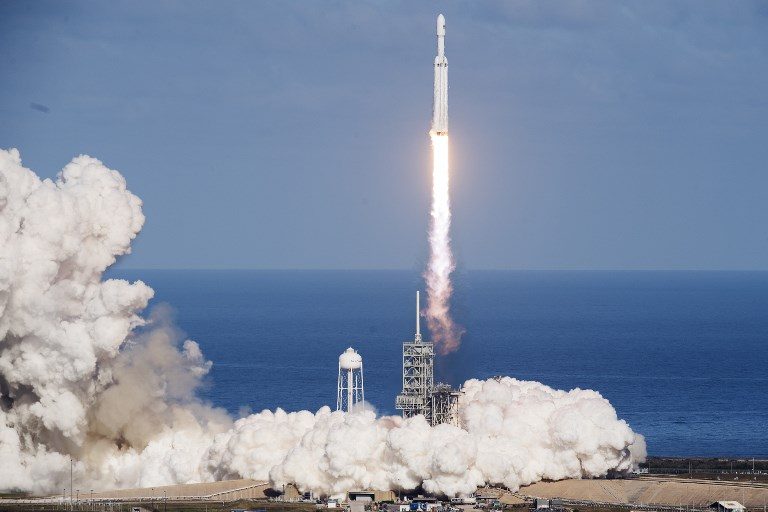SUMMARY
This is AI generated summarization, which may have errors. For context, always refer to the full article.

CAPE CANAVERAL, USA (UPDATED) – The world’s most powerful rocket, SpaceX’s Falcon Heavy, blasted off Tuesday, February 6, on its highly anticipated maiden test flight, carrying CEO Elon Musk’s cherry red Tesla Roadster toward an orbit near Mars.
Screams and cheers erupted at mission control in Cape Canaveral, Florida as the massive rocket fired its 27 engines and rumbled into the blue sky over the same NASA launchpad that served as a base for the US missions to the Moon four decades ago.
“The mission went as well as one could have hoped,” an ecstatic Musk told reporters after the launch, calling it “probably the most exciting thing I have seen literally ever.”
“I had this image of a giant explosion on the pad with a wheel bouncing down the road with the Tesla logo landing somewhere,” he said. “Fortunately that is not what happened.”
Loaded with Musk’s red Tesla and a mannequin in a spacesuit, the monster rocket’s historic test voyage captured the world’s imagination.
SpaceX’s webcast showed the Tesla Roadster soaring into space, as David Bowie’s Space Oddity played in the background – with the words “DON’T PANIC” visible on the dashboard, in an apparent nod to the sci-fi series Hitchhiker’s Guide to the Galaxy.
Musk posted a live video showing the “Starman” mannequin appearing to cruise, its gloved hand on the wheel, through the darkness of space, with the Earth’s image reflected on the car’s glossy red surface.
If the Roadster survives its 5-hour journey through the Van Allen Belt – a region of high radiation where it will be pelted with charged particles – it will attempt a final burn toward Mars, Musk said.
Then, the car would enter an orbit around the Sun that brings it close to Mars, on a journey that could last a billion years and take it as far as 250 million miles (400 million kilometers) from Earth, the same as a trip around the equator 10,000 times.
“Maybe it will be discovered by some future alien race,” Musk told reporters. “What were these guys doing? Did they worship this car?” he mused.
More about the status of the car’s journey is expected in the coming hours.
The Roadster was also outfitted with a data storage unit containing Isaac Asimov’s science fiction book series, the Foundation Trilogy, and a plaque bearing the names of 6,000 SpaceX employees.
‘Giant step’
About two minutes into the flight, the two side boosters peeled away from the center core and made their way back toward Earth for an upright landing.
Both rockets landed side by side in unison on launchpads, live video images showed.
“New Olympic sport – Synchronized Landings!” wrote NASA astronaut Randy Bresnik on Twitter.
The third, center booster failed to land on an ocean platform – known as a droneship – as planned.
“It didn’t have enough propellant,” Musk said, adding that it plunged into the ocean about 100 meters (yards) away from its landing point.
“Apparently it hit the water at 300 miles (480 kilometers) an hour and took out two of the engines,” he added.
Experts said the launch would likely catch the eye of the US space agency NASA, which may consider using the Falcon Heavy as a way to fast-track its plans to reach the Moon again for the first time since 1972.
Acting NASA Administrator Robert Lightfoot congratulated SpaceX and called it a “tremendous accomplishment.”
Kennedy Space Center Director Bob Cabana said “the successful launch of a new vehicle on its first flight is a significant accomplishment they can be very proud of.”
Canadian astronaut Chris Hadfield tweeted: “What we’re watching is @SpaceX leaving all other rocket companies in the dust. Congrats to everyone there!”
Falcon Heavy specs
The Falcon Heavy launched from the same NASA pad that was the base for the Apollo-era Moon missions of the 1960s and 1970s.
It is “the most powerful operational rocket in the world by a factor of two,” SpaceX said.
That means it can carry twice the payload of United Launch Alliance’s Delta IV Heavy, at a far lower cost – about $90 million per launch compared to $350 million for its competitor.
But the Falcon Heavy is not the most powerful rocket ever – just the biggest in operation today.
The Saturn V rocket that propelled astronauts to the Moon could deliver more payload to orbit. The Soviet-era Energia, which flew twice in 1987 and 1988, was also more powerful.
The Falcon Heavy is essentially 3 smaller, Falcon 9 rockets strapped together, adding up to a total of 27 engines.
The 230-foot (70-meter) tall rocket is designed to carry nearly 141,000 pounds (64 metric tonnes) into orbit – more than the mass of a fully loaded 737 jetliner.
It was initially intended to restore the possibility of sending humans to the Moon or Mars, but those plans have shifted and now the Falcon Heavy is being considered mainly as a potential equipment carrier to these deep space destinations, Musk said Monday, February 5.
Instead, another rocket and spaceship combination being developed by SpaceX, nicknamed BFR – alternately known as “Big Fucking Rocket,” or “Big Falcon Rocket” – would be the vehicle eventually certified for travelers. – Rappler.com
Add a comment
How does this make you feel?
There are no comments yet. Add your comment to start the conversation.